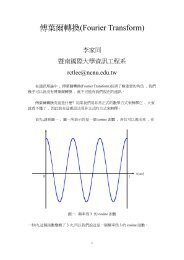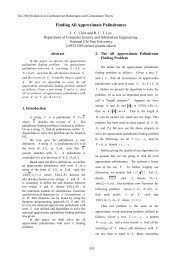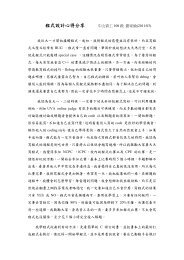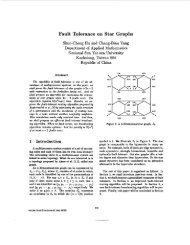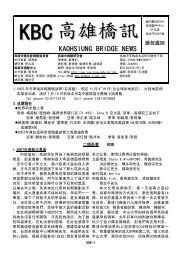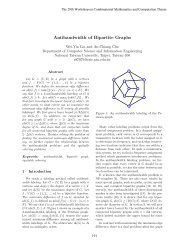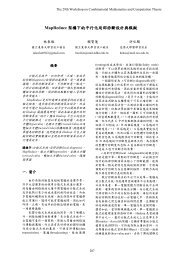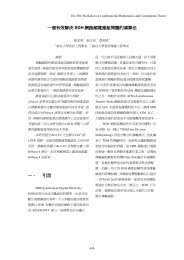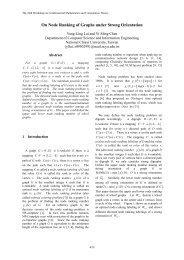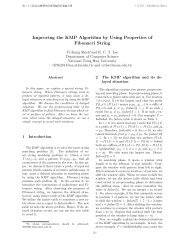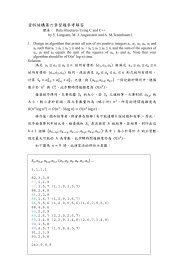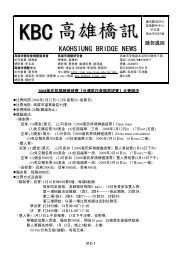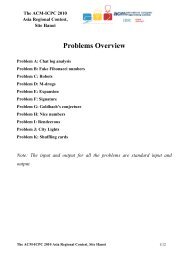The Weighted All-Pairs-Shortest-Path-Length Problem on Two ...
The Weighted All-Pairs-Shortest-Path-Length Problem on Two ...
The Weighted All-Pairs-Shortest-Path-Length Problem on Two ...
You also want an ePaper? Increase the reach of your titles
YUMPU automatically turns print PDFs into web optimized ePapers that Google loves.
<str<strong>on</strong>g>The</str<strong>on</strong>g> 25th Workshop <strong>on</strong> Combinatorial Mathematics and Computati<strong>on</strong> <str<strong>on</strong>g>The</str<strong>on</strong>g>ory<br />
respectively. By this notati<strong>on</strong>, G(r) is just the<br />
original input graph G. In another, each n<strong>on</strong>-leaf<br />
node u of T is associated with a label lb(u). Assume<br />
that q and f are the children of u. If G(u) = G(q) •<br />
G(f), then lb(u) = S and u is called a S-node.<br />
Otherwise, it implies that G(u) = G(q) + G(f). In this<br />
case, lb(u) = P and u is called a P-node. Fig. 4 shows<br />
a TTSP graph G and a corresp<strong>on</strong>ding parsing tree T.<br />
In [19], the authors investigated literatures <strong>on</strong><br />
TTSP graphs for some problems, such as the<br />
minimum feedback vertex problem and the<br />
maximum independent set. Meanwhile, in [8], the<br />
authors shown that APSPL problem <strong>on</strong> planar<br />
graphs with n<strong>on</strong>negative edge-weights can be<br />
2<br />
solved in O( n ) time. But the time-complexity so<strong>on</strong><br />
increases to O(<br />
n<br />
7<br />
3<br />
log( nL)<br />
) if negative<br />
edge-weights are allowed, where L is the absolute<br />
value of the most negative edge-weight. <str<strong>on</strong>g>The</str<strong>on</strong>g> class of<br />
TTSP graphs is an important subclass of planar<br />
graphs. This paper will establish a meaningful<br />
improvement: the WAPSPL problem <strong>on</strong> TTSP<br />
2<br />
graphs can be solved in O( n ) time.<br />
2<br />
3. An O( n )-Time Algorithm<br />
It is so trivial to solve our problem when the input<br />
graph c<strong>on</strong>sists <strong>on</strong>ly a single edge. <str<strong>on</strong>g>The</str<strong>on</strong>g>refore, we<br />
assume that the input graph G c<strong>on</strong>sists of at least two<br />
edges hereafter. To go <strong>on</strong> our discussi<strong>on</strong>, the<br />
following definiti<strong>on</strong>s are introduced firstly.<br />
Definiti<strong>on</strong> 1: For any node z of T(r), the nodes in the<br />
path from z to the root r, except z itself, are called the<br />
ancestors of z.<br />
Definiti<strong>on</strong> 2: For any two distinct vertices<br />
v<br />
j<br />
and<br />
of G(r), the lowest comm<strong>on</strong> ancestor of and<br />
v<br />
j<br />
, denoted as LCA({ vi<br />
, v<br />
j<br />
}) is defined as<br />
follows: (1) If ( vi<br />
, v<br />
j<br />
) is an edge of G(r), then it<br />
implies that ( vi<br />
, v<br />
j<br />
) corresp<strong>on</strong>ds to some leaf node<br />
z and LCA({ vi<br />
, v<br />
j<br />
}) is defined to be z itself. (2) If<br />
( v , v ) is not an edge of G(r), then there must<br />
i<br />
j<br />
exist two leaf nodes p and q such that<br />
v i<br />
vi<br />
is the <strong>on</strong>e<br />
vertex of the edge corresp<strong>on</strong>ding to p and is the<br />
<strong>on</strong>e vertex of the edge corresp<strong>on</strong>ding to q. In this<br />
situati<strong>on</strong>, LCA({ vi<br />
, v<br />
j<br />
}) is defined to be the node<br />
u farthest from r such that u is a ancestor of both p<br />
and q.<br />
v i<br />
v j<br />
S<br />
<br />
(v 1, v 3)<br />
S<br />
<br />
v 1<br />
P<br />
<br />
v 2<br />
(v 6, v 7) (v 1, v 4)<br />
v 3<br />
v 4<br />
S<br />
<br />
P<br />
<br />
(v 7, v 8)<br />
S<br />
<br />
v 6<br />
v 5<br />
v 8<br />
v 7<br />
(v 1, v 2)<br />
S<br />
<br />
(v 4, v 7) (v 2, v 5)<br />
S<br />
<br />
(v 5, v 8)<br />
P<br />
<br />
(v 3, v 6)<br />
Remarks:<br />
For each n<strong>on</strong>-leaf node u, denotes the terminals of G(u).<br />
Figure 4: A TTSP graph G and its corresp<strong>on</strong>ding<br />
parsing tree T.<br />
Definiti<strong>on</strong> 3: Suppose that u is a P-node of T(r). u is<br />
called a bottom P-node if all nodes of T(u) are either<br />
S-nodes or leaf nodes, except u itself. Otherwise, u is<br />
called a n<strong>on</strong>-bottom P-node. In additi<strong>on</strong>, u is called a<br />
top P-node if the ancestors of u in T(r) are all<br />
S-nodes. If u is not a top P-node, then u is called a<br />
n<strong>on</strong>-top P-node. By this definiti<strong>on</strong>, u can be a top<br />
P-node and a bottom P-node at the same time.<br />
Definiti<strong>on</strong> 4: For any bottom P-node u of T(r),<br />
pair_set(u) is defined as {{ vi<br />
, v<br />
j<br />
} | vi<br />
, v<br />
j<br />
∈<br />
V(G(u))}<br />
Definiti<strong>on</strong> 5: For any n<strong>on</strong>-bottom P-node u of T(r),<br />
pair_set(u) is defined as {{ vi<br />
, v<br />
j<br />
} | vi<br />
, v<br />
j<br />
∈<br />
V(G(u))} – ∪<br />
pair_set( v)<br />
.<br />
for all P-node<br />
v≠u<br />
of T ( u)<br />
Definiti<strong>on</strong> 6: For each n<strong>on</strong>-top P-node u, the lowest<br />
P-node ancestor of u, denoted as LPNA(u) is the<br />
P-node f satisfying the following c<strong>on</strong>diti<strong>on</strong>s: (1) f is<br />
nearest to u, and (2) f is in the path from u to the root<br />
r.<br />
Definiti<strong>on</strong> 7: For each n<strong>on</strong>-leaf node z of T(r), let q<br />
and f be the left child and the right child of z,<br />
respectively. Define left_descendants(z) = {x | x is a<br />
node in T(q).} and right_descendants(z) = {x | x is a<br />
node in T(f).}<br />
<str<strong>on</strong>g>The</str<strong>on</strong>g> following lemma can be easily established.<br />
Lemma 1: For any two distinct vertices vi<br />
, v<br />
j<br />
of<br />
G(r), there exists at most <strong>on</strong>e P-node u such that<br />
(v 2, v 8)<br />
-356-



